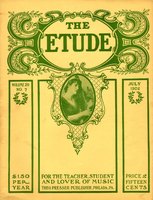A London periodical called the Music Student, and bearing on its title-page the grave announcement that it is “a scholastic musical monthly for professor and pupil,” is presenting to its readers, in instalments, an article entitled: “The Secret of the Art of Practising the Violin, or How to Overcome its Difficulties.” The author of this article is one J. J. Haakman, who, it is but charitable to surmise, penned his thoughts in the French language and left the delicate task of translation to the editor of the Music Student.
Before commenting on Mr. Haakman’s article, justice demands that he be held blameless for the quality of the English employed in interpreting his thoughts. Surely an article bearing so imposing a title, and calculated to engage the interest of serious students, deserves to be written in a clear style and with the utmost correctness and precision. But Mr. Haakman’s translator, whoever he may be, has so unfelicitously chosen his sentences and his words that it is hardly reasonable to expect to arouse the interest of an intelligent student.
It may be said, in extenuation of much of the literary dribble offered to our music-students, that not all, or even many, musicians have the gift of language, and that what the student really needs is not a polished literary effort, but rather helpful suggestions bearing on his art, however crudely these may be expressed. But the point we wish to make is this: An article obviously intended to help the student should contain good, if not original, thoughts, clothed in the simplest, clearest language. It is this very clarity of thought and expression that determines the value of any effort of the mind. A pretentious article that proves to contain only platitudes, or one that is so ambiguous in conception and expression as to perplex the intelligent reader, is nearly always worthless and sometimes even harmful.
But to return to Mr. Haakman’s article in the Music Student.
When a writer solemnly essays to divulge “the secret of the art of practising the violin,” and gains the confidence of his readers by further assuring them that he will inform them “how to overcome its difficulties,” it is not unreasonable to expect to find in such an article a few words of wisdom and some practical, helpful suggestions. But in Mr. Haakman’s article we look in vain for even a partial fulfillment of his promise. He tells his readers that it requires “from nine to ten hours’ daily practice” to acquire astounding technic; that “whatever is played by the artist must be absolutely faultless”; that “moist fingers may be troublesome to the strings” (does he mean the strings or the player?); that, “to be an artist of the first type, one must possess the physique, the nerve, and the mind to play in all sorts of weather”; and, with incomprehensible gravity, he devotes a column or more to the purpose of convincing his readers that it is quite impossible to retain, in old age, the flexibility and digital facility acquired in youth.
The student who has the time and the patience to read all of Mr. Haakman’s effusion will naturally wonder whether the writer really believes he has made good his promise to his readers. Also, he will wonder how such things come to be written and printed; and he will naturally arrive at the conclusion that, if such articles are the best product of serious men, then he will have to probe, alone and unaided, “the secret of the art of practising the violin.”



